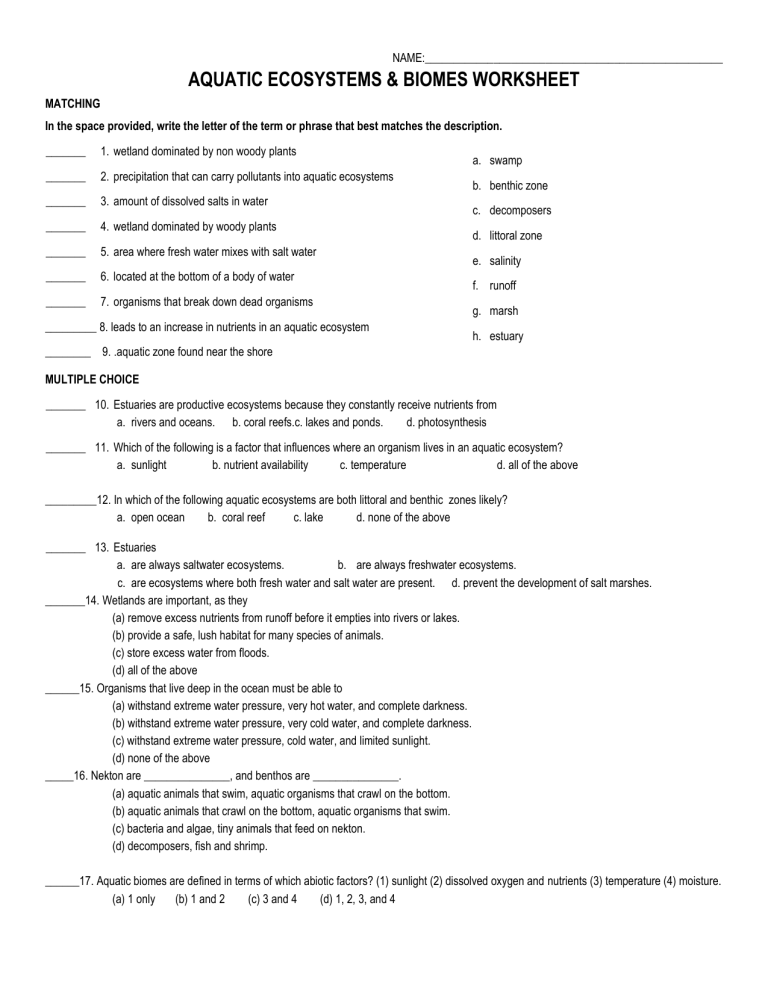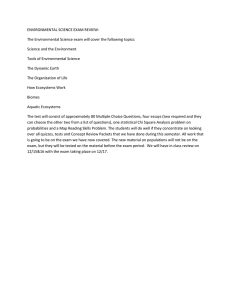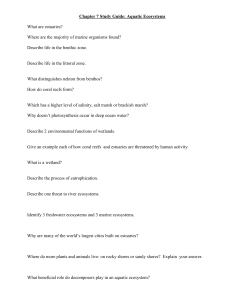
NAME:____________________________________________________ AQUATIC ECOSYSTEMS & BIOMES WORKSHEET MATCHING In the space provided, write the letter of the term or phrase that best matches the description. _______ 1. wetland dominated by non woody plants _______ 2. precipitation that can carry pollutants into aquatic ecosystems _______ 3. amount of dissolved salts in water _______ 4. wetland dominated by woody plants _______ 5. area where fresh water mixes with salt water _______ 6. located at the bottom of a body of water _______ 7. organisms that break down dead organisms _________ 8. leads to an increase in nutrients in an aquatic ecosystem a. swamp b. benthic zone c. decomposers d. littoral zone e. salinity f. runoff g. marsh h. estuary ________ 9. .aquatic zone found near the shore MULTIPLE CHOICE _______ 10. Estuaries are productive ecosystems because they constantly receive nutrients from a. rivers and oceans. b. coral reefs.c. lakes and ponds. d. photosynthesis _______ 11. Which of the following is a factor that influences where an organism lives in an aquatic ecosystem? a. sunlight b. nutrient availability c. temperature d. all of the above _________12. In which of the following aquatic ecosystems are both littoral and benthic zones likely? a. open ocean b. coral reef c. lake d. none of the above _______ 13. Estuaries a. are always saltwater ecosystems. b. are always freshwater ecosystems. c. are ecosystems where both fresh water and salt water are present. d. prevent the development of salt marshes. _______14. Wetlands are important, as they (a) remove excess nutrients from runoff before it empties into rivers or lakes. (b) provide a safe, lush habitat for many species of animals. (c) store excess water from floods. (d) all of the above ______15. Organisms that live deep in the ocean must be able to (a) withstand extreme water pressure, very hot water, and complete darkness. (b) withstand extreme water pressure, very cold water, and complete darkness. (c) withstand extreme water pressure, cold water, and limited sunlight. (d) none of the above _____16. Nekton are _______________, and benthos are _______________. (a) aquatic animals that swim, aquatic organisms that crawl on the bottom. (b) aquatic animals that crawl on the bottom, aquatic organisms that swim. (c) bacteria and algae, tiny animals that feed on nekton. (d) decomposers, fish and shrimp. ______17. Aquatic biomes are defined in terms of which abiotic factors? (1) sunlight (2) dissolved oxygen and nutrients (3) temperature (4) moisture. (a) 1 only (b) 1 and 2 (c) 3 and 4 (d) 1, 2, 3, and 4 Section: Marine Ecosystems Estuaries support many marine organisms because estuaries receive plenty of light for photosynthesis and plenty of nutrients for plants and animals. Rivers supply nutrients that have been washed from the land, and because the water is shallow, sunlight can reach all the way to the bottom of the estuary. The light and nutrients support large populations of rooted plants as well as plankton. The plankton in turn provides food for larger animals, such as fish. Dolphins, manatees, seals, and other mammals often feed on fish and plants in estuaries. Oysters, barnacles, and clams live anchored to marsh grass or rocks and feed by filtering plank ton out of the water. Organisms that live in estuaries are able to tolerate variations in salinity because the salt content of the water varies as fresh water and salt water mix when tides go in and out. Estuaries provide protected harbors, access to the ocean, and connection to a river. As a result, many of the world’s major ports are built on estuaries. Of the 10 largest urban areas in the world, 6 were built on estuaries. These 6 cities are Tokyo, New York Shanghai, Buenos Aires, Rio de Janeiro, and Bombay. 18. What types of organisms do estuaries support? ______________________________________________________________________________________ 19. How do oysters, barnacles, and clams feed? ______________________________________________________________________________________ 20. What do dolphins, seals, and other mammals eat? ______________________________________________________________________________________ 21. What two ingredients make estuaries suitable for plants and animals? ______________________________________________________________________________________ 22.. How many of the world’s 10 largest urban areas are built on estuaries? What concerns might this cause for wildlife? ______________________________________________________________________________________ ______________________________________________________________________________________ 23) What are the main limiting factors of aquatic organisms? _________________________ __________________________________ General ocean knowledge: 24) Aquatic biomes are divided into zones based on the amount of _________________ they receive. 25) What defines where the aphotic zone begins? 26) Would you expect to find algae in the aphotic or photic zone of an aquatic biome? Why? 5) Would you expect to find more dissolved nutrients near the shore of a lake or the middle of a lake? Why? 6) Aquatic biomes in the ocean are called _________________ biomes. 7) You find an organism that has special organs for excreting excess salt. Would you expect this organism to be from a lake or ocean? Why? 8) The narrow strip along the coastline covered by water at high tide and exposed to air at low tide is known as the _________________ zone. 9) What is a chemoautotroph? Where do we find them in the ocean? Who am I? Identify the following aquatic biomes that we have discussed in class: Ocean, Estuary, Coral reef, Coastal beach, Inland wetlands 1. I am 90% of the marine area but contain only 10% of its species ______ _________ 2. Freshwater from rivers and saltwater from the ocean mix here ______ 3. My biome can be classified as a marsh, prairie pothole, or bog______ ___________ 4. My freshwater doesn’t move ______ ___________ 5. I am a living animal that is host to several symbiotic relationships. _____ ___________ 6. No sunlight reaches parts of my biome ______ __________ 7. I act as a natural barrier against battering waves and storms ______ ___________ 8. Hydrothermal vents are found in the hadal zone of my biome ______ ___________ 9. I play a major role in regulating the earth’s climate ______ ___________ 10. When developers build on the dunes found in this biome they increase the risk of damage from storms ______ 11. This biome provides habitat, reduces flooding, improves water quality by filtering pollutants, and helps replenish groundwater supplies ______ ___________ 12. The Florida Everglades are an example of my biome ______ ___________ t/f 13. Temperature gets cooler as you move away from the equator. _____ 14. Terrestrial biomes include all the land and water areas on Earth where organisms live. _____ 15. Sunlight penetrates roughly 200 meters into the water. _____ 16. Climate is the average weather in an area over a long period of time. _____ 17. The growing season may last all year in a hot, wet climate. _____ 18. Temperature refers to the conditions of the atmosphere from day to day. _____ 19. Phytoplankton are tiny animals that feed on zooplankton. _____ 20. Climate determines plant growth. _____ 21. Plankton are tiny aquatic organisms that swim around in the photic zone. _____ 22. The photic zone is water deeper than 200 meters. _____ 23. Aquatic biomes in the ocean are called marine biomes. _____ 24. When aquatic organisms die, they sink to the bottom, so water near the bottom may contain more nutrients than water at other depths. _______________ Compare and Contrast: Using a double bubble diagram compare and contrast the following terms: 25. Oligotrophic and Eutrophic 26. Photic zone and aphotic zone 27. Intertidal zone and Benthic Zone 28.






